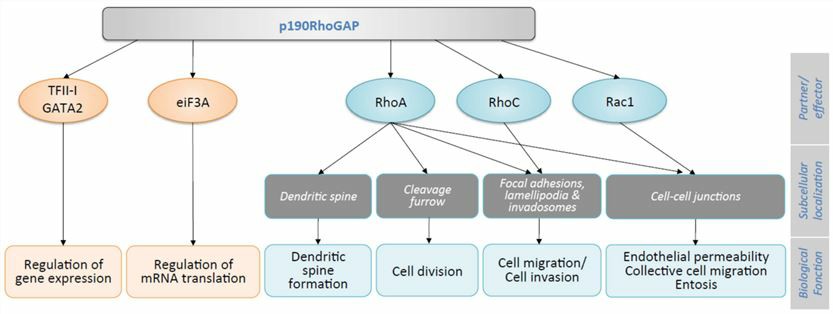ARHGAP35 and Associated Diseases
Creative Biolabs is a preclinical CRO that provides the best-customized solutions to the biotechnology and pharmaceutical industries. A strong team, a desire to innovate, and customer satisfaction are at our core. Our long-term expertise and tailored solutions support your research from the early stages to the final stages of product development.
Backgrounds of ARHGAP35 Gene
p190RhoGAP homologs P190RhogGAP-A (p190A, glucocorticoid receptor DNA-binding Factor 1 (GRF-1), or GRLF1, encoded by the ARHGAP35 gene) and p190RhoGAP-B (p190B, Encoded by the ARHGAP5 gene) corresponds to two major GAPs that regulate the small GTPase Rho family. The ARHGAP35 gene is conserved in a wide variety of species, including chimpanzees, rhesus monkeys, dogs, cattle, mice, rats, chickens, zebrafish, fruit flies, mosquitoes, and frogs.
p190RhoGAP Cellular Functions
ARHGAP35 encodes p190A RhoGAP (p190A), a large GTPase-activating protein associated with cell adhesion, cell migration, cytokinesis, cilia, cytophagocytosis, gene transcription, and protein translation. Thus, ARHGAP35 is an essential gene, and p190A does play a key role in development. Because their enzyme activity includes an increase in the rate of GTP hydrolysis, and therefore a decline in the biological function of small GTPases, GAP is often labeled as a signal termination factor. However, due to interactions with key partners, GAP can also act as a signal starter and/or transmitter. Other functions of p190A, such as endothelial permeability, cell aggregation and migration, intracellular action, cell division, and synaptic transmission. These roles are linked to p190A redistribution at either intercellular junctions, cleavage furrows, or dendritic spines. ARHGAP35 increases cell invasion and migration and induces or promotes the development of pterygia. RhoGAP protein p190A (Arhgap35, Grlf1) is an effective regulator of Rho GTPases. It consists of an N-terminal GTPase domain, a series of conserved FF domains, and a C-terminal RhoGAP domain, which are essential for its activity.
 Fig.1 Cellular functions of p190A. (Héraud, 2019)
Fig.1 Cellular functions of p190A. (Héraud, 2019)
ARHGAP35 in Diseases
- Neuronal Diseases
In the nervous system, by inhibiting RhoA and subsequently regulating cellular actomyosin contractile force, p190A coordinates behavioral adaptation outcomes such as reduced vulnerability to exposure to stress hormones, as well as vulnerability to drug abuse. ARHGAP35 is a gene whose expression is negatively correlated with APC1, which the scientists linked with the transcription repressor of the glucocorticoid receptor (NR3C1) to stress response. Mice lacking the functional p190A protein died shortly after birth and had some defects in neuronal development. This defect results in abnormal neuronal morphologies and abnormalities in hemispheric fusion, ventricle shape, optic cup formation, neural tube closure, and cortical stratification.
- Cancer
P190A was originally described as a substrate for the oncoprotein c-Src, interacting with p120RasGAP, a key regulator of Ras oncogenes, and subsequently described as promoting fibroblast transformation. Consistent with tumor inhibition, ARHGAP35 is localized to the 19q13.3 chromosome region, which is also frequently absent in glioma, pancreatic, ovarian, and thyroid tumors. p190A is overexpressed at protein or mRNA levels in many types of cancer and may affect patient prognosis. P190A is involved in cell adhesion within TEB, and its absence alters mammary epithelial differentiation.
Creative Biolabs is committed to providing the highest quality service with timely and accurate results and, when needed, expert advice from highly qualified staff. If you encounter problems with your gene therapy research project, please do not hesitate to contact our experts to discuss and provide you with reasonable solutions.
Reference
- Héraud, C.; et al. p190RhoGAPs, the ARHGAP35-and ARHGAP5-encoded proteins, in health and disease. Cells. 2019, 8(4): 351. Distributed under Open Access license CC BY 4.0, without modification.
